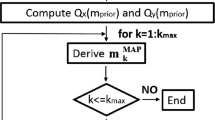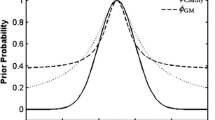Abstract
Economic shale gas production requires hydraulic fracture stimulation to increase the formation permeability. Hydraulic fracturing strongly depends on geomechanical parameters such as Young’s modulus and Poisson’s ratio. Fracture-prone sweet spots can be predicted by prestack inversion, which is an ill-posed problem; thus, regularization is needed to obtain unique and stable solutions. To characterize gas-bearing shale sedimentary bodies, elastic parameter variations are regarded as an anisotropic Markov random field. Bayesian statistics are adopted for transforming prestack inversion to the maximum posterior probability. Two energy functions for the lateral and vertical directions are used to describe the distribution, and the expectation–maximization algorithm is used to estimate the hyperparameters of the prior probability of elastic parameters. Finally, the inversion yields clear geological boundaries, high vertical resolution, and reasonable lateral continuity using the conjugate gradient method to minimize the objective function. Antinoise and imaging ability of the method were tested using synthetic and real data.
Similar content being viewed by others
References
Alemie, W., and Sacchi, M. D., 2011, High-resolution three-term AVO inversion by means of a Trivariate Cauchy probability distribution: Geophysics, 76(3), R43–R55.
Besag, J., 1974, Spatial interaction and the statistical analysis of lattice systems: Journal of the Royal Statistical Society, 36(2), 192–236.
Buland, A., and Omre, H., 2003, Bayesian linearized AVO inversion: Geophysics, 68(1), 185–198.
Charbonnier, P., Blanc-Feraud, L., Aubert, G., and Barlaud, M., 1997, Deterministic edge-preserving regularization in computed imaging: IEEE Transactions on Image Processing, 6(2), 298–311.
Chen, J. J., Yin, X. Y., and Zhang, G. Z., 2007, Simultaneous three term AVO inversion based on Bayesian theorem: Journal of China University of Petroleum (Edition of Natural Science), 31(3), 33–38.
Close, D., Perez, M., Goodway, B., and Purdue, G., 2012, Integrated workflows for shale gas and case study results for the Horn River Basin, British Columbia, Canada: The Leading Edge, 31(5), 556–569.
Downton, J. E., 2005, Seismic parameter estimation from AVO inversion: University of Calgary.
Geman, S., and Geman, D., 1984, Stochastic relaxation, Gibbs distributions, and the Bayesian restoration of images: IEEE Trans. Pattern Anal. Mach. Intell. 6(6), 721–741.
Gholami, A., 2015, Nonlinear multichannel impedance inversion by total-variation regularization: Geophysics, 80(5), R217–R224.
Goodway, B., Varsek, J., and Abaco, C., 2010, Seismic petrophysics and isotropic-anisotropic AVO methods for unconventional exploration: The Leading Edge, 29(12), 1500–1508.
Huber, J., 1973, Robust regression: Asymptotics, Conjectures and Monte Carlo: Annals of Statistics, 1(5), 799–821
Liu, C., Li, B. N., Zhao, X., Liu, Y., and Lu, Q., 2014, Fluid identification based on frequency-dependent AVO attribute inversion in multi-scale fracture media: Applied Geophysics, 11(4), 384–394.
Rimstad, K., and Omre, H., 2010, Impact of rock-physics depth trends and Markov random fields on hierarchical Bayesian lithology/fluid prediction: Geophysics, 75(4), R93–R108.
Schultz, R. R., and Stevenson, R. L., 1994, A Bayesian approach to image expansion for improved definition: IEEE Transactions on Image Processing, 3(3), 233–242.
Theune, U., Jensås, I. Ø., and Eidsvik, J., 2010, Analysis of prior models for a blocky inversion of seismic AVA data: Geophysics, 75(3), C25–C35.
Tian, Y. K., Zhou, H., and Yuan, S. Y., 2013a, Lithologic discrimination method based on Markov random-field: Chinese Journal of Geophysics, 56(4), 1360–1368.
Tian, Y. K., Zhou, H., Chen, H. M., Zou, Y. M., and Guan, S. J., 2013b, Bayesian prestack seismic inversion with a self-adaptive Huber-Markov random-field edge protection scheme: Applied Geophysics, 10(4), 453–460.
Tikhonov, A., 1963, Solution of incorrectly formulated problems and the regularization method: Soviet Math Dokl 4 English translation of Dokl Akad Nauk SSSR, 151, 1035–1038.
Ulvmoen, M., Omre, H. and Buland, A., 2010, Improved resolution in Bayesian lithology/fluid inversion from prestack seismic data and well observations: Part 2-Real case study: Geophysics, 75(2), B73–B82.
Walker, C., and Ulrych, T. J., 1983, Autoregressive recovery of the acoustic impedance: Geophysics, 48(10), 1338–1350.
Xiong, F. S., and Wang, S. T., 2006, Application of MAP estimation based on Gaussian Markov random field in gaussian noise filter: Journal of Computer Applications, 26(10), 2362–2365.
Youzwishen, C. F., and Sacchi, M. D., 2006, Edge preserving imaging: Journal of Seismic Exploration, 15(1), 45–58.
Yuan, S. Y., and Wang, S. X., 2013, Edge-preserving noise reduction based on Bayesian inversion with directional difference constraints: Journal of Geophysics and Engineering, 10(2), 025001.
Yuan, S. Y., Wang, S. X., Luo, C. M., and He, Y. X., 2015, Simultaneous multitrace impedance inversion with transform-domain sparsity promotion: Geophysics, 80(2), R71–R80.
Zhang, H. M., Yuan, Z. J., Cai, Z. M., and Bian, Z. Z., 2002, Segmentation of MRI Using Hierarchical Markov Random Field: Journal of Software, 13(9), 1779–1786.
Author information
Authors and Affiliations
Corresponding author
Additional information
This work was supported by CNPC fundamental research project (No. 2014E-3204).
Wang Kang-Ning Ph.D. graduated from China University of Petroleum (Beijing) in 2014. Her main research interests are seismic prestack inversion and reservoir prediction.
Rights and permissions
About this article
Cite this article
Wang, KN., Sun, ZD. & Dong, N. Prestack inversion based on anisotropic Markov random field–maximum posterior probability inversion and its application to identify shale gas sweet spots. Appl. Geophys. 12, 533–544 (2015). https://doi.org/10.1007/s11770-015-0518-9
Received:
Revised:
Published:
Issue Date:
DOI: https://doi.org/10.1007/s11770-015-0518-9




